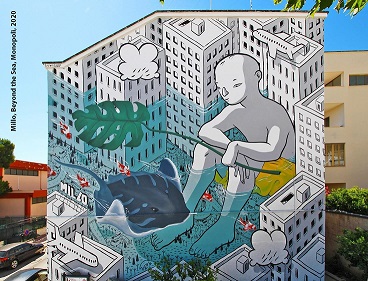Reframing “the most holy spot in Ireland”: an analysis of the narratives from and around Kilmainham Gaol
DOI:
https://doi.org/10.54103/2035-7680/18687Parole chiave:
Kilmainham Gaol; competing narratives; curatorial choices; reframing; Irish nationalism; representational challengesAbstract
Prisons play a prominent role in Irish imagination and collective memory, because their wings and cells bore witness to many turning points in the country’s recent history. Kilmainham Gaol, often called ‘the Bastille of Ireland’, is no exception: from 1796 to its closure in 1924, it held the leaders of nineteenth-century agrarian and nationalist revolts as well as the Easter Rising rebels in 1916. Given the Gaol’s importance in nationalist history, it has been argued that a specific narrative came to be constructed around it by its restorers: one aimed at elevating the Gaol to a symbol of the separatist struggle, and which deliberately downplayed the fact that the prison had been a place of detention also for non-political prisoners and the opponents of the Free State. Scholars contend that this narrative long dominated over stories of ordinary penal history, and, only recently, brief mentions of ‘ordinary’ prisoners and the Civil War have entered the dominant narrative. My article questions these assumptions and is divided into two parts to outline such ‘reframing’ of Kilmainham Gaol: first, drawing on archival documents, I discuss the intention of the authorities to redesign Ireland’s past as a monolithic history of struggle against the enemies of the nation in their narrative of the Gaol, and I argue for the need to consider their reasons to do so; second, I resort to Witcomb’s methodological approach to highlight how today’s curators respond to the representational challenges posed by the Gaol and aim at incorporating into the narrative of the site the dissonant voices of those who had been previously neglected.
Metriche
Riferimenti bibliografici
Arnold-de Simine, Silke. Mediating Memory in the Museum: Trauma, Empathy, Nostalgia. Palgrave, 2013.
Augusteijn, Joost. Patrick Pearse: The Making of a Revolutionary. Palgrave Macmillan, 2010.
Aykaç, Pinar. “Musealisation as a Strategy for the Reconstruction of an Idealised Ottoman Past: Istanbul’s Sultanahmet District as a ‘Museum-quarter’.” International Journal of Heritage Studies, vol. 25, no. 2, 2019, pp. 160-177.
Casella, Eleanor C. “Prisoner of His Majesty: Postcoloniality and the Archaeology of British Penal Transportation.” World Archaeology, vol. 37, no. 3, 2005, pp. 453-467.
Cauvin, Thomas, and Ciaran O’Neill. “Negotiating Public History in the Republic of Ireland: Collaborative, Applied and Usable Practices for the Profession.” Historical Research: the Bulletin of the Institute of Historical Research, vol. 90, no. 250, 2017, pp. 810-828.
Clark, Gemma. Everyday Violence in the Irish Civil War. Cambridge University Press, 2014.
Cooke, Pat. A History of Kilmainham Gaol 1796-1924. Office of Public Works, 1995.
---. “Art and Kilmainham Gaol: Negotiating Art’s Critical Intervention in the Heritage Site.” Art and Archaeology, 2014, pp. 83-97.
---. The Politics and Polemics of Culture in Ireland, 1800-2010. Routledge, 2021.
De Valera, Éamon. “Speech at the opening of the Kilmainham Gaol Historical Museum”. 10 April 1966. https://www.storiesfrom1916.ie/. Accessed 14 Jan. 2022.
Egan, Sean. “Kilmainham Gaol A Labour Of Love 1963.” RTÉ News, 14 May 1963. https://www.rte.ie/archives/2018/0430/959230-kilmainham-gaol-restoration/. Accessed 9 Sept. 2021.
English, Richard. Irish Freedom: The History of Nationalism in Ireland. Macmillan, 2008.
Hachey, Thomas E. Turning Points in Twentieth Century Irish History. Irish Academic Press, 2011.
Hennes, Tom. “Remembering and Disremembering: A Museum Perspective.” Curator, vol. 55, no. 2, 2012, pp. 129-138.
Jarrin, Casey A. “The Prison Gallery: Exhibit Collaboration Between Kilmainham Gaol and Alcatraz.” Irish Studies: Geographies and Genders, edited by Marti D. Lee and Ed Madden, Cambridge Scholars, 2008, pp. 49-59.
Kearney, Richard. Transitions: Narratives in Modern Irish Culture. Manchester University Press, 1988.
KJRS [Kilmainham Jail Restoration Society]. Ghosts of Kilmainham. Kilmainham Jail Restoration Society, 1963.
---. Kilmainham: the Bastille of Ireland. Kilmainham Jail Restoration Society, 1982.
Laird, Heather. Commemorations. Cork University Press, 2018.
Leonard, Lorcan. Letter to Sean Dowling, Chairman of the Association of the Old IRA, 9 June 1958.
Lindstrand, Fredrik, and Eva Insulander. “Setting the Ground for Engagement – Multimodal Perspectives on Exhibition Design.” Designs for Learning, vol. 5, no. 1-2, 2012, pp. 30-49.
Logan, William S., and Keir Reeves. Places of Pain and Shame: Dealing with ‘Difficult Heritage’. Routledge, 2009.
MacDonagh, Oliver. States of Mind. A Study of Anglo-Irish Conflict 1780-1980. Allen & Unwin, 1983.
MacDonald, Sharon. A Companion to Museum Studies. Blackwell, 2006.
McAtackney, Laura. An Archaeology of the Troubles: The Dark Heritage of Long Kesh/Maze Prison. Oxford University Press, 2014.
---. “Material and Intangible Interventions as Future-Making Heritage at Kilmainham Gaol, Dublin.” Journal of Contemporary Archaeology, vol. 6, no. 1, 2019, pp. 120-135.
McBride, Ian R. History and Memory in Modern Ireland. Cambridge University Press, 2001.
McCann, Fiona. The Carceral Network in Ireland: History, Agency and Resistance. Palgrave, 2020.
McCarthy, Mark. Ireland’s 1916 Rising: Explorations of History-making, Commemoration & Heritage in Modern Times. Routledge, 2016.
McCorkel, Jill, and Anna DalCortivo. “Prison Tourism in the Age of Mass Incarceration.” Contexts, vol. 17, no. 3, 2018, pp. 63-65..
McLoughlin, Kate. The Cambridge Companion to War Writing. Cambridge University Press, 2009.
Naguib, Saphinaz-Amal. “Museums, Diasporas and the Sustainability of Intangible Cultural Heritage.” Sustainability, vol. 5, no. 5, 2013, pp. 2178-2190.
O’Dwyer, Rory. The Bastille of Ireland. Kilmainham Gaol: From Ruin to Restoration. History Press Ireland, 2010.
O’Malley-Younger, Alison. “A Terrible Beauty is Bought: 1916, Commemoration and Commodification.” Irish Studies Review, vol. 24, no. 4, 2016, pp. 455-467.
O’Sullivan, Niamh. Every Dark Hour: A History of Kilmainham Jail, foreword by Sinéad McCoole, Liberties Press, 2007.
O’Toole, Fintan. “In A State.” In a State. An Exhibition in Kilmainham Gaol on National Identity, edited by Jobst Graeve, Dublin Project Press, 1991.
Programme of commemoration held by Republican Women Prisoners of War in Kilmainham on April 24 1923. Kilmainham Gaol Archives, KMGLM 2015.0086.
Reynolds, Paige. Modernism, Drama, and the Audience for Irish Spectacle. Cambridge University Press, 2007.
Ruczaj, Maciej. “Liturgy of Nation-Formation: Patrick Pearse and the Theological Background of the Easter Rising of 1916: Liturgy of Nation-Formation.” Studies in Ethnicity and Nationalism, vol. 13, no. 3, 2013, pp. 412-428.
Smith, Laurajane. “Theorizing Heritage and Museum Visiting.” The International Handbook of Museum Studies: Museum Theory, edited by Andrea Witcomb and Kylie Message, John Wiley & Sons, 2015, pp. 459-484.
Smith, Nadia Clare. Dorothy Macardle: A Life. Woodfield Press, 2007.
Witcomb, Andrea. “Beyond Sentimentality and Glorification: Using a History of Emotions to Deal with the Horror of War.” Memory, Place and Identity: Commemoration and Remembrance of War and Conflict, edited by Danielle Drozdzewski et al., Routledge, 2016, pp. 205-220.
Zuelow, Eric. “Enshrining Ireland’s Nationalist History Inside Prison Walls: The Restoration of Kilmainham Jail.” Éire-Ireland, vol. 39, no. 3, 2004, pp. 180-201.
---. Making Ireland Irish: Tourism and National Identity since the Irish Civil War. Syracuse University Press, 2009.
Dowloads
Pubblicato
Come citare
Fascicolo
Sezione
Licenza

Questo articolo è soggetto a licenza Creative Commons Attribution-NonCommercial-NoDerivatives 3.0 International License.




